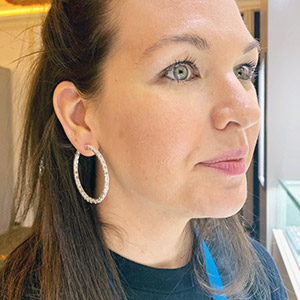
In The Jewelry District’s first-ever video podcast, JCK editor-in-chief Victoria Gomelsky and news director Rob Bates sit down with JCK managing editor Melissa Rose Bernardo to discuss buzzworthy trends in categories from colored stones to diamonds. With JCK Las Vegas opening on June 6 and Luxury on June 4, it’s the ideal time to catch up on the latest looks, from creative new gold and pearl earrings to Mocha Mousse gems and Guatemalan jade. JCK’s experts also analyze what surging gold prices mean for retailers and designers and share a silver lining of tumultuous times—jewelry as an emotional support purchase.
Watch Now
Episode Credits
Hosts: Rob Bates and Victoria Gomelsky
Producer: Natalie Chomet
Video: Jack Belisle
Engineer: Sean Paulsen
Editor: Carol Hartsell
Show Notes
1:21 Gold Diggers
10:54 Pearl Renaissance
14:10 Brownie Points
17:34 Jade Makes the Grade
22:25 Colorful Thinking
25:32 Diamond Trends
33:19 Emotional Support Jewelry
Show Recap
Gold Diggers
Rob wonders how today’s staggering gold prices ($2,973 per ounce when the podcast was recorded) are likely to affect the JCK show in Las Vegas this year. Victoria predicts the impact will vary based on whether jewelers offer high-end, mid-range, or more affordable product. At the high end, “a lot of jewelers have just leaned in,” she says. “They’re raising their prices, obviously, and in a lot of instances, they’re seeing their clients go with them.” Retailers at the other end of the spectrum will likely stop carrying certain designers whose product is now out of their customers’ price range.
The gold price was a hot topic at the VicenzaOro show in January, Melissa reports. “People who want to buy gold are going to buy, no matter the price,” she says. “People are still buying.”
Victoria recalls a recent conversation with an L.A.-based jeweler who specializes in 18k gold; he told her he’ll continue to make pieces no matter what the price, though perhaps focus on smaller collections. “Gold is so intrinsic to this fine jewelry world. There’s just no other substitute,” she says, though she does see more retailers promoting platinum for bridal.
She predicts that jewelers will take a “smarter approach” with gold, and make their pieces a bit lighter with more negative space. But she adds that even as the price rose over 2024, “we saw a lot of statement pieces in gold, pieces that seemed to defy the economy, defy the market.”
Rob explains that economic and political tumult tend to drive gold prices up, because people view the metal as a safe haven. Central banks, nervous about sanctions and eager to “de-dollarize,” are now focusing on gold. China in particular has been buying gold, a trend he thinks will continue.
Melissa shares some of the current trends showcased in JCK’s upcoming gold jewelry feature. Among them are statement pieces, snakes, collar necklaces, big and bold looks reminiscent of the ’80s and ’90s, and fun links with elongated or shortened shapes, loops, knots, and beads. Gold and pearl earrings are trending, too, reflecting a growing enthusiasm for pearl jewelry.
Pearl Renaissance
Rob wonders how pearls, once dismissed as old-fashioned and basic, suddenly got hip. “Pop culture had a lot to do with it,” Melissa explains, noting that male celebs helped kickstart the craze, particularly when Harry Styles started wearing pearls.
Victoria adds that Pharrell Williams recently designed a collection for Tiffany & Co. called Tiffany Titan, much of which incorporates pearls. “When Pharrell’s choosing pearls, you know they’ve hit the…cultural zeitgeist.”
The newest looks are more luxe and contemporary, often baroque, multicolor, golden, or Tahitian. While designers are infusing new creativity into pearl pieces, even a classic strand of white pearls can look edgy if it’s styled right, Victoria says.
In addition, pearls “resonate with a lot of younger buyers because they’re organic,” Victoria says, noting they signify healthy oysters and, by extension, a healthy oceanic environment. Even if people don’t make that connection directly, they may gravitate to pearls that without knowing exactly why.
Another selling point for retailers: Pearls are a great entry point for shoppers, with a variety of affordable options from freshwater to baroque now trending, according to Melissa.
Brownie Points
The conversation turns to Pantone’s 2025 Color of the Year, Mocha Mousse, which showed up at the gem shows in Tucson in the form of smoky topaz and brown zircon. Pantone’s picks generally don’t move the needle for jewelers, but Victoria says she heard people at Tucson talking about it. “Maybe because it’s an unexpected color,” she says. “Right now, people are really gravitating to slightly offbeat colors.”
Victoria explains that trends in colored stones are often driven by supply rather than demand. Unlike fashion designers, jewelry designers start with what’s available to buy and then build collections around that. If certain colors aren’t coming out of the ground or being cut, they aren’t offered in the marketplace, so designers can’t work with them, Victoria explains.
Jade Makes the Grade
One prime example of a trend springing from availability is jade, which generated a lot of excitement at the gem shows in Tucson. “There’s a fresh supply coming out of Guatemala of really gorgeous translucent blue-green jade,” Victoria says, adding that she’s enjoyed researching the material because of its rich heritage. “They call it the stone of heaven in China,” where jade pieces are often treasured heirlooms handed down through generations.
“I love that people are finally coming around to jade and all of its infinite color possibilities,” says Melissa. “There are incredible high jewelry designs with jade.”
Victoria adds that not only are Hong Kong jewelers reinterpreting it in new ways, but more designers in the West are embracing the gemstone.
Colorful Thinking
Jade is just one of the gems in JCK’s upcoming colored stones feature, which also spotlights opal and paraiba tourmaline. In the past few months, an “incredible range” of paraiba has come out, including green stones from Mozambique that contrast the traditional “Windex blue” from Brazil, Melissa reports.
On the downside, paraiba can cost up to $100,000 a carat at wholesale, and it’s hard to find larger stones, Victoria points out.
Diamond Trends
Lab-grown diamond manufacturers are turning their attention to pieces with bigger stones, responding to consumer demand for large gems “with a bigger look” at more affordable prices, Rob says.
Rob wonders if lab-grown makers will start to explore different shapes and colors. “There’s so much more you can do with lab-grown you can do with natural,” he says. “There’s just so much possibility that isn’t taken advantage of yet.”
Fashion, too, is fertile ground for lab-grown diamonds, says Victoria, pointing to GRWN, a company founded by former Hyde Park Jewelers exec Michael Pollak and his son, which recently introduced a line of snapback baseball caps featuring lab-grown diamonds in a range of colors for $450 at retail.
Melissa offers a sneak peek at JCK’s recent diamond jewelry shoot, which showcases such trends as elongated stones and mixed cuts everywhere from rings to necklaces and bracelets.
Rob is curious about what to expect from heavy hitters in the diamond world at JCK Las Vegas. Last year, some of the biggest names in natural diamonds were on hand to promote their latest marketing campaigns and remind buyers they were still in the game—a move he thinks buoyed post-show spirits, even if that optimism was only temporary. “We’ll see if it continues this year,” he says.
Victoria theorizes that lab-grown could be prompting a counter trend: a growing fondness among buyers of natural diamond engagement rings toward lower colors. These consumers want to differentiate their purchases from the colorless, flawless look of lab-grown stones, she explains, so they’re embracing warmer stones with a funkier, more eclectic look. “It’s just a much more eclectic selection of stones that people are gravitating to,” she says. “[They] don’t look like the diamonds we would have put on the cover a few years ago.”
Emotional Support Jewelry
On the five-year anniversary of the COVID-19 lockdown, Rob asks his colleagues to weigh on how jewelry styling has changed since 2020.
Victoria says one silver living of the pandemic was it gave rise to a new generation of jewelers. Creatives who had long dreamed of a career designing jewelry found themselves stuck at home and decided to give it a try. “We got this infusion of talent,” she says.
Melissa has seen more sentimental jewelry—talismans, keepsakes, zodiac symbols, and other personal pieces—gain popularity, especially among self-purchasers, since 2020.
Rob concludes that following times of turmoil, jewelry tends to do well, because it’s a emotion-based product. “We all need emotional support jewelry,” Melissa concludes.
Any views expressed in this podcast do not reflect the opinion of JCK, its management, or its advertisers.
- Subscribe to the JCK News Daily
- Subscribe to the JCK Special Report
- Follow JCK on Instagram: @jckmagazine
- Follow JCK on X: @jckmagazine
- Follow JCK on Facebook: @jckmagazine






